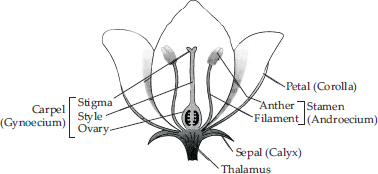How Do Organisms Reproduce - NCERT Questions
Asexual reproduction takes place through budding in
| A | Amoeba |
| B | yeast |
| C | Plasmodium |
| D | Leishmania. |
Answer-(b) Yeast
Q 2.Which of the following is not a part of the female reproductive system in human beings?
| A | Ovary |
| B | Uterus |
| C | Vas deferens |
| D | Fallopian tube |
Answer-(c) Vas deferens
Q 3.The anther contains
| A | sepals |
| B | ovules |
| C | carpel |
| D | pollen grains. |
Answer-(d) Pollen grains
Q 4.What are the advantages of sexual reproduction over asexual reproduction?
SOLUTION:
Sexual reproduction has the following advantages over asexual reproduction:
(i) Sexual reproduction involves fusion of male and female gametes coming from male and female parents. Since the fusing gametes come from two different and sexually distinct individuals, the off springs exhibit diversity of characters.
(ii) Meiosis during game to genesis provides opportunities for new combination of genes. It plays a prominent role in the origin of new species and leads to variations required for evolution.
What are the functions performed by the testis in human beings?
SOLUTION:
(i) Testes are the sites where male gametes, i.e., sperms are produced.
(ii) The testes also produce the male sex hormone-testosterone.
Why does menstruation occur?
SOLUTION:Menstruation is bleeding from the uterus of human females at an interval of about 28/29 days. Since the ovary releases one egg every month, the uterus also prepares itself every month to receive a fertilized egg. Thus its lining becomes thick and spongy. This would be required for nourishing the embryo if fertilization had taken place. However, in the absence of fertilization, this lining is not needed any longer. So, the lining slowly breaks and comes out through the vagina as blood and mucous. Thus, menstruation occurs to discard the uterine lining and unfertilized ovum in the absence of fertilization.
Q 7.Draw a labelled diagram of the longitudinal section of a flower.
SOLUTION:The labelled diagram of the longitudinal section of a flower is as follows:

Fig: L.S. of a flower
What are the different methods of contracep-tion?
SOLUTION:Different methods of contraception are :
(i) Barrier methods
(ii) Chemical methods
(iii) Intrauterine Contraceptive Devices (IUCDs)
(iv) Natural methods
(v) Surgical methods.
(i) Barrier methods: These are physical devices to prevent the entry of sperm in the female genital tract during copulation e.g., condom, diaphragm etc.
(ii) Chemical methods: Foam tablets, creams, jellies, pastes, etc. are inserted in the vagina before intercourse to prevent sperms from entering the uterus. Oral pills are the hormonal pills which are used to check ovulation.
(iii) Intrauterine Contraceptive Devices (IUCDs): These devices are inserted by doctors or expert nurses in the uterus through vagina. These suppress the fertilizing capacity of sperms and prevent the implantation of embryo in the uterus e.g., CuT, progestasert, etc.
(iv) Natural methods : These methods include abstinence (avoid copulation), rhythm method (avoid copulation around the time of ovulation) and coitus interrupt us (withdrawal of penis before ejaculation).
(v) Surgical methods : These methods block gamete transport and hence prevent fertilization. Sterilization procedure in the male is termed as vasectomy and in the female is termed as tubectomy. Both of these methods are very effective.
How are the modes of reproduction different in unicellular and multicellular organisms?
SOLUTION:Unicellular organisms generally reproduce asexually by fission, budding and spore formation. They have only one celled body and can multiply easily by simple cell division. The multicellular organisms use both asexual and sexual methods for reproduction. While simple multicellular organisms usually follow the asexual methods of reproduction; the complex multicellular organisms reproduce mainly by sexual reproduction.
Q 10.How does reproduction help in providing stability to populations of species?
SOLUTION:Reproduction is the only means to ensure the continuity of a species. By reproduction, organisms produce large number of new individuals out of which several get perished and only some survive. These surviving organisms replace the naturally dying members of the population. Hence the population as a whole is not affected and remains stable.
Q 11.What could be the reasons for adopting contraceptive methods?
SOLUTION:Contraceptive methods are adopted:
(i) to avoid unwanted birth.
(ii) to regulate the proper spacing between pregnancies.
(iii) to keep the population of a country under control.
(iv) to maintain a ratio between home economy and size of the family.